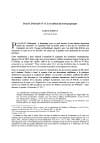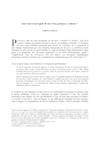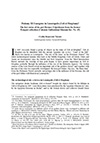Ptolémée III Évergète
« Polybe, PtolĂ©mĂ©e IV et la tradition historiographique »
ENiM 2, 2009, p. 91-101.
 Les historiens antiques et à leur suite, un grand nombre d'historiens modernes, ont sévèrement critiqué le quatrième souverain de l'Égypte hellénistique, Ptolémée Philopator, et au delà de la figure historique, leur jugement s'est naturellement focalisé sur le bilan de son règne. Cet état de fait tient en grande partie à la tradition transmise par Polybe et reprise par ses successeurs. Cependant, une remise en question de cette vision trop négative est perceptible depuis une quarantaine d´années grâce à une relecture des sources et à une analyse nouvelle des faits (dont certains inconnus des historiens de la première moitié du XXe siècle). Cet article propose de faire un point sur cette question.
Les historiens antiques et à leur suite, un grand nombre d'historiens modernes, ont sévèrement critiqué le quatrième souverain de l'Égypte hellénistique, Ptolémée Philopator, et au delà de la figure historique, leur jugement s'est naturellement focalisé sur le bilan de son règne. Cet état de fait tient en grande partie à la tradition transmise par Polybe et reprise par ses successeurs. Cependant, une remise en question de cette vision trop négative est perceptible depuis une quarantaine d´années grâce à une relecture des sources et à une analyse nouvelle des faits (dont certains inconnus des historiens de la première moitié du XXe siècle). Cet article propose de faire un point sur cette question.
 The ancient historians and at their turn, a large number of modern historians have severely criticized the forth sovereign of Hellenistic Egypt, Ptolemy IV Philopator and beyond the historic figure, they based their judgment on the facts of his reign. This situation is, in large part, the result of the tradition transmitted by Polybius and taken over by his successors. Nevertheless, this very negative perspective has been looked at differently during the last forty years due to reviewing the sources and reanalyzing the facts (some of which were unknown to the historians of the first half of the 20th century). This article aims to make a point in this matter.
The ancient historians and at their turn, a large number of modern historians have severely criticized the forth sovereign of Hellenistic Egypt, Ptolemy IV Philopator and beyond the historic figure, they based their judgment on the facts of his reign. This situation is, in large part, the result of the tradition transmitted by Polybius and taken over by his successors. Nevertheless, this very negative perspective has been looked at differently during the last forty years due to reviewing the sources and reanalyzing the facts (some of which were unknown to the historians of the first half of the 20th century). This article aims to make a point in this matter.
 Consulter cet article (59088) -
Consulter cet article (59088) -  Télécharger cet article au format pdf (31087)
Télécharger cet article au format pdf (31087)
« Quel souverain lagide fit don d’un gymnase Ă Athènes ? »
ENiM 9, 2016, p. 65-77.
 Le gymnase était à l’époque hellénistique un véritable symbole de la culture grecque et représentait le mode de vie hellène par excellence. Or, un souverain lagide fonda à Athènes – cité de culture entre toutes et qui disposait déjà notamment des gymnases du Lycée et de l’Académie – un nouvel édifice à une date qui reste indéterminée et dont la localisation n’est pas aisée. Cet article propose de retracer le contexte politique de la cité athénienne au IIIe siècle afin de tenter d’identifier quel fut le Ptolémée bienfaiteur de la cité.
Le gymnase était à l’époque hellénistique un véritable symbole de la culture grecque et représentait le mode de vie hellène par excellence. Or, un souverain lagide fonda à Athènes – cité de culture entre toutes et qui disposait déjà notamment des gymnases du Lycée et de l’Académie – un nouvel édifice à une date qui reste indéterminée et dont la localisation n’est pas aisée. Cet article propose de retracer le contexte politique de la cité athénienne au IIIe siècle afin de tenter d’identifier quel fut le Ptolémée bienfaiteur de la cité.
 The gymnasium was in the Hellenistic period a symbol of Greek culture and represented the Hellenic way of life. Interestingly, a Ptolemaic sovereign founded in Athens – the most cultural famous city and which already had gymnasiums like The Lyceum and the Academy – a new building at a date still unknown and whose location is not easy. This article aims to retrace the political context of the Athenian city in the third century in an attempt to identify who was the Ptolemy’s benefactor of the city.
The gymnasium was in the Hellenistic period a symbol of Greek culture and represented the Hellenic way of life. Interestingly, a Ptolemaic sovereign founded in Athens – the most cultural famous city and which already had gymnasiums like The Lyceum and the Academy – a new building at a date still unknown and whose location is not easy. This article aims to retrace the political context of the Athenian city in the third century in an attempt to identify who was the Ptolemy’s benefactor of the city.
 Consulter cet article (49263) -
Consulter cet article (49263) -  Télécharger cet article au format pdf (27370)
Télécharger cet article au format pdf (27370)
« Ptolemy III Euergetes in Leontopolis (Tell el-Moqdam)? The lost statue of the god Hermes-Triptolemus from the former Fouquet collection (Calouste Gulbenkian Museum Inv. No. 45) »
ENiM 14, 2021, p. 91-114.
 En 1885, le médecin et collectionneur français Daniel Marie Fouquet acheta chez l’antiquaire Souliman Abd es-Samad un groupe d’objets provenant des ruines de Tell el-Moqdam, l’ancienne ville de Léontopolis. Cette découverte est connue sous le nom de « Trouvaille des lions ». Parmi ces objets il y avait également quatre bronzes hellénistiques : un sphinx, un oinochoé, une figure de pêcheur et une statue du dieu Hermès. Tous ces bronzes ont été publiés en 1911 par l’archéologue français Paul Perdrizet dans son livre Bronzes Grecs d’Égypte de la Collection Fouquet. Quelques années plus tard l’archéologue allemand Hans Peter Laubscher reprit l’étude de la statue d’Hermès et il l’interpréta comme étant un roi ptolémaïque en tant que dieu Hermès-Horus-Triptolemus. L’étude de Laubscher était fondée uniquement sur les photos prises pour la vente aux enchères de 1922 de la Collection Fouquet à Paris, car le lieu de conservation de la statue était inconnu. L’auteur a pu identifier la statue d’Hermès au Musée Calouste Gulbenkian de Lisbonne sous le numéro 45.
Grâce à cette identification il a été possible de la rediscuter et de revoir les affirmations de Perdrizet et Laubscher. Il a été également possible d’explorer pour la première fois toute la composition de la statue puisque les photos publiées ne montrent pas sa base. D’après l’étude iconographique qui tient en compte les interprétations de Perdrizet et Laubscher, la statue doit certainement être interprétée comme Ptolémée III Évergète représenté en tant que dieu Hermès-Triptolème. Elle montre Ptolémée III comme semeur divin, pourvoyeur et garant de l’abondance, de la prospérité et de la paix. La fonction de la statue permet de remettre en question le prétendu contexte archéologique de sa découverte grâce aussi aux résultats de la recherche sur la provenance de tous les objets issus des ruines de Tell el-Moqdam en 1885.
En 1885, le médecin et collectionneur français Daniel Marie Fouquet acheta chez l’antiquaire Souliman Abd es-Samad un groupe d’objets provenant des ruines de Tell el-Moqdam, l’ancienne ville de Léontopolis. Cette découverte est connue sous le nom de « Trouvaille des lions ». Parmi ces objets il y avait également quatre bronzes hellénistiques : un sphinx, un oinochoé, une figure de pêcheur et une statue du dieu Hermès. Tous ces bronzes ont été publiés en 1911 par l’archéologue français Paul Perdrizet dans son livre Bronzes Grecs d’Égypte de la Collection Fouquet. Quelques années plus tard l’archéologue allemand Hans Peter Laubscher reprit l’étude de la statue d’Hermès et il l’interpréta comme étant un roi ptolémaïque en tant que dieu Hermès-Horus-Triptolemus. L’étude de Laubscher était fondée uniquement sur les photos prises pour la vente aux enchères de 1922 de la Collection Fouquet à Paris, car le lieu de conservation de la statue était inconnu. L’auteur a pu identifier la statue d’Hermès au Musée Calouste Gulbenkian de Lisbonne sous le numéro 45.
Grâce à cette identification il a été possible de la rediscuter et de revoir les affirmations de Perdrizet et Laubscher. Il a été également possible d’explorer pour la première fois toute la composition de la statue puisque les photos publiées ne montrent pas sa base. D’après l’étude iconographique qui tient en compte les interprétations de Perdrizet et Laubscher, la statue doit certainement être interprétée comme Ptolémée III Évergète représenté en tant que dieu Hermès-Triptolème. Elle montre Ptolémée III comme semeur divin, pourvoyeur et garant de l’abondance, de la prospérité et de la paix. La fonction de la statue permet de remettre en question le prétendu contexte archéologique de sa découverte grâce aussi aux résultats de la recherche sur la provenance de tous les objets issus des ruines de Tell el-Moqdam en 1885.
 In 1885 the French doctor and collector Daniel Marie Fouquet bought from the antique dealer Souliman Abd es-Samad a group of objects found in the ruins of Tell el-Moqdam (Leontopolis). This find is known as “Trouvaille des lions”. Among the objects purchased by Dr. Fouquet there were four Hellenistic bronzes: a sphinx, an oinochoe, a figure of a fisherman and a statue of the god Hermes. All these bronzes were published by the French archaeologist Paul Perdrizet in his book Bronzes Grecs d’Égypte de la Collection Fouquet in 1911. The German archaeologist Hans Peter Laubscher took up the study of the statue of Hermes found in Leontopolis and interpreted it as a Ptolemaic king depicted as the god Hermes-Horus-Triptolemus. Laubscher’s study was based only on photos of the statue because it had been missing since 1922, when it was auctioned as part of the Fouquet collection in Paris. The author was able to localize the statue of Hermes in the Calouste Gulbenkian Museum in Lisbon under the number 45.
By locating the statue, it is possible to re-discuss it and to review the previous claims of Perdrizet and Laubscher. It is also possible to explore the entire composition for the first time since the published photos of the statue do not show its base. After an iconographical study and considering the interpretations of Perdrizet and Laubscher, the statue can certainly be interpreted as Ptolemy III Euergetes depicted as the god Hermes-Triptolemus. The statue of the Calouste Gulbenkian Museum Inv. No. 45 shows Ptolemy III as divine sower, provider and guarantor of abundance, prosperity, and peace. The function of the statue as temple statue allows a re-discussion about the archaeological context by questioning the provenance of all the objects found in 1885 in the ruins of Tell el-Moqdam (Leontopolis).
In 1885 the French doctor and collector Daniel Marie Fouquet bought from the antique dealer Souliman Abd es-Samad a group of objects found in the ruins of Tell el-Moqdam (Leontopolis). This find is known as “Trouvaille des lions”. Among the objects purchased by Dr. Fouquet there were four Hellenistic bronzes: a sphinx, an oinochoe, a figure of a fisherman and a statue of the god Hermes. All these bronzes were published by the French archaeologist Paul Perdrizet in his book Bronzes Grecs d’Égypte de la Collection Fouquet in 1911. The German archaeologist Hans Peter Laubscher took up the study of the statue of Hermes found in Leontopolis and interpreted it as a Ptolemaic king depicted as the god Hermes-Horus-Triptolemus. Laubscher’s study was based only on photos of the statue because it had been missing since 1922, when it was auctioned as part of the Fouquet collection in Paris. The author was able to localize the statue of Hermes in the Calouste Gulbenkian Museum in Lisbon under the number 45.
By locating the statue, it is possible to re-discuss it and to review the previous claims of Perdrizet and Laubscher. It is also possible to explore the entire composition for the first time since the published photos of the statue do not show its base. After an iconographical study and considering the interpretations of Perdrizet and Laubscher, the statue can certainly be interpreted as Ptolemy III Euergetes depicted as the god Hermes-Triptolemus. The statue of the Calouste Gulbenkian Museum Inv. No. 45 shows Ptolemy III as divine sower, provider and guarantor of abundance, prosperity, and peace. The function of the statue as temple statue allows a re-discussion about the archaeological context by questioning the provenance of all the objects found in 1885 in the ruins of Tell el-Moqdam (Leontopolis).
 Consulter cet article (46092) -
Consulter cet article (46092) -  Télécharger cet article au format pdf (20192)
Télécharger cet article au format pdf (20192)
ENiM 18 - 2025
8 article(s) - 8 octobre 2025.
ENiM 1 à 18 (2008-2025) : 227 articles
5 189 178 téléchargements
10 356 279 consulations.
Index des auteurs

Mots clés

Derniers articles : 
CENiM - Mise en ligne des volumes Ă©puisĂ©s : 
 Anne-Sophie von BOMHARD DĂ©cans Ă©gyptiens, CENiM 23, Montpellier, 2020 — (2020)
Anne-Sophie von BOMHARD DĂ©cans Ă©gyptiens, CENiM 23, Montpellier, 2020 — (2020) 
 Jean-Claude Grenier L'Osiris ANTINOOS, CENiM 1, Montpellier, 2008 — (26 dĂ©cembre 2008)
Jean-Claude Grenier L'Osiris ANTINOOS, CENiM 1, Montpellier, 2008 — (26 dĂ©cembre 2008) 
TDENiM - Mise en ligne des volumes Ă©puisĂ©s : 
 Twitter
Twitter 4146655 visites - 4534 visite(s) aujourd’hui - 63 connecté(s)
© ENiM - Une revue d’égyptologie sur internet
Équipe Égypte Nilotique et Méditerranéenne - UMR 5140 - « Archéologie des Sociétés Méditerranéennes » (Cnrs) - Université Paul Valéry - Montpellier III
























 Contact
Contact
 Abonnez-vous !
Abonnez-vous ! Équipe Égypte Nilotique et Méditerranéenne
Équipe Égypte Nilotique et Méditerranéenne UMR 5140 « Archéologie des Sociétés Méditerranéennes » (Cnrs)
UMR 5140 « Archéologie des Sociétés Méditerranéennes » (Cnrs) Université Paul Valéry - Montpellier III
Université Paul Valéry - Montpellier III